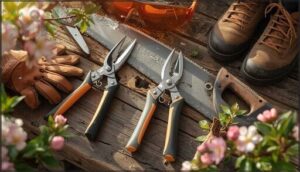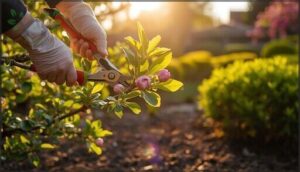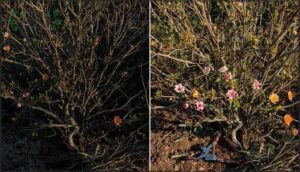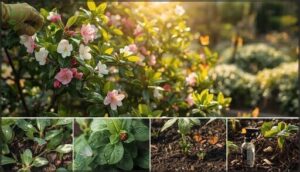This site is supported by our readers. We may earn a commission, at no cost to you, if you purchase through links.

Most pruning mistakes happen because gardeners follow generic advice instead of understanding how their specific shrubs set flower buds—cut a lilac in fall, and you’ve just removed next spring’s blooms.
The key is matching your maintenance schedule to each shrub’s growth cycle, from soil preparation that encourages strong root systems to strategic cuts that boost flowering potential. Small adjustments in how you approach spring flowering shrub care transform struggling plants into reliable performers that deliver color year after year.
Table Of Contents
Key Takeaways
- Success with spring flowering shrubs depends on matching your pruning schedule to each plant’s bloom cycle—cutting at the wrong time removes next year’s flower buds before they ever open.
- Proper soil preparation with pH testing and organic amendments creates the foundation for vigorous root systems that support reliable blooms year after year.
- Strategic thinning cuts after flowering improve air circulation and sunlight penetration by up to 50%, dramatically reducing fungal disease risk while boosting future bloom potential.
- Integrated pest management using beneficial insects like ladybugs can cut chemical pesticide use by 71% while maintaining healthy shrubs that resist common problems naturally.
Choosing Spring Flowering Shrubs
Selecting the right spring-flowering shrubs for your garden starts with understanding which plants will thrive in your specific conditions and meet your landscape goals. You’ll want to think about factors like climate compatibility, maintenance requirements, and whether the shrubs attract pollinators or resist deer browsing.
Here’s what you need to know to make informed choices that will reward you with reliable, vibrant blooms each spring.
Popular Spring-Blooming Shrub Varieties
Spring blooms deliver a vibrant tapestry to your garden, and choosing the right spring flowering shrubs sets the tone. Explore these standout shrub varieties for early-season impact:
- Forsythia Care yields bright, arching yellow sprays
- Quince varieties add red, pink, or coral hues
- Witch-Hazel blooms persist for weeks
- Viburnum fragrance perfumes the air
- Azalea cultivars dazzle with vivid color
For a thriving garden, consider the importance of native shrub options.
Selecting Shrubs for Your Climate Zone
When considering new shrubs, always size up their hardiness zone fit—think of Climate Zone Mapping as your garden’s roadmap. Hardiness levels and shrub adaptation decide who thrives year after year.
With warming trends shifting zones north, select varieties proven for your region’s planting and growing conditions. Shrubs for different zones guarantee blooms won’t vanish with tomorrow’s climate.
For ideal growth, consider using heat tolerant plants in your garden.
Deer-Resistant and Pollinator-Friendly Options
As you match shrubs to your climate, don’t overlook the value of deer-resistant, pollinator-friendly options. Garden diversity and ecosystem balance go hand-in-hand when you choose native shrubs that deter browsing deer and attract early bees and butterflies.
For a thriving wildlife garden, mix these staples:
- Forsythia’s yellow spring show
- Inkberry holly’s glossy resilience
- American beautyberry’s pollinator party
Compact and Low-Maintenance Choices
If you want flourishing color without constant upkeep, compact shrub varieties and dwarf selections fit the bill. Dwarf lilacs, Spiraea japonica, and Low Scape Mound chokeberry pack vivid spring blooming power into a space-efficient form.
These low maintenance, deer-resistant shrubs thrive in borders or containers, making low-maintenance landscaping feel entirely possible—even for gardeners pressed for space or time.
Planting and Soil Preparation
Getting your spring flowering shrubs off to a good start takes more than picking the right plant. How you handle planting and soil preparation sets the stage for healthy roots and lasting blooms.
Here’s what to keep in mind as you get ready to put them in the ground.
Best Planting Times for Spring Shrubs
Ever notice how timing can make or break your blooming success? In most climate zones, the best guide is soil temperature—steady between 55°F and 75°F.
Plant spring flowering shrubs after the last frost date for your area to give roots a strong start. Aim early enough for root establishment, but never plant into cold or overly wet ground.
Soil Requirements and Amendments
To lay the best groundwork, focus on soil pH levels and organic matter. Most spring shrubs thrive in well-drained soil with pH 6.0–7.0—though azaleas crave even more acidic soil. Spotting nutrient deficiencies early pays off.
Follow these basics:
- Run soil testing before planting.
- Amend with compost annually.
- Adjust pH as needed.
- Apply fertilizer based on tests.
Proper Planting Techniques
When success is the goal, attention to Hole Preparation, Planting Depth, and Shrub Spacing is key. You’ll want the root ball sitting level with the soil, not deeper, and the planting hole at least twice as wide. Follow this planting guide—select healthy shrubs, mind soil pH, and keep roots well-spread for ideal well-drained soil contact.
| Step | Planting and Care Tips | Practical Example |
|---|---|---|
| Hole Prep | Twice root ball width, not deeper | 18–24″ wider for azaleas |
| Root Placement | Spread roots outward, firm soil | Prevents constriction |
| Spacing | Space half mature width apart | 2–3′ for most shrubs |
Mulching for Moisture and Health
Mulching is the bedrock for thriving spring shrubs. A well-placed layer of organic materials—bark, pine needles, or compost—does more than dress the bed. It:
- Locks in soil moisture during dry spells
- Regulates soil temperature
- Drastically cuts back on weeds
- Nurtures well-drained soil and healthy roots
Invest in proper mulching for manageable watering and ideal soil conditions.
Essential Pruning Techniques
Pruning isn’t just about keeping things tidy—it shapes how your spring shrubs grow and bloom each year. Knowing when and how to make the cut makes a real difference.
Here’s what to keep in mind for the most effective pruning.
Timing Pruning for Maximum Bloom
Picture your spring flowering shrubs as athletes preparing for peak performance—timing is everything. To release maximum bloom potential, stick with pruning schedules that follow flowering, not before.
Effective pruning techniques include light thinning and selective cuts right after blooms fade. Post bloom care ensures new buds set promptly, while severe pruning delays growth and slashes future flower displays.
Tools and Safety for Effective Pruning
Before beginning any pruning techniques for shrubs, take garden plant care tips seriously: sharp, clean pruning saws and hand pruners are non-negotiable. Use ergonomic grips for comfort, don proper safety gear—gloves, glasses, boots—and always inspect tools.
Tool maintenance prevents accidents and ensures clean cuts, making shrub care more effective and keeping you safe through each season’s pruning routine.
Step-by-Step Pruning Methods
With pruning tools in hand, start by clearing away dead or diseased wood, then look for branches that cross or point inward. For best branch management, always cut just above an outward-facing bud.
Effective cutting techniques—thinning out older stems at ground level, heading back overlong branches—keep your spring flowering shrubs vigorous, lush, and bloom-ready on a dependable pruning schedule.
Managing Overgrown or Neglected Shrubs
When shrubs slip out of shape from years of neglect, bold steps restore their vigor. Rejuvenation Pruning works wonders, though patience is key—severe cuts can delay blooming for several seasons. For best Shrub Restoration, focus on:
- Removing one-third of the oldest stems each year
- Thinning dense growth for air circulation
- Tackling overgrowth in stages for lasting Neglect Recovery
Watering, Fertilization, and Maintenance
Keeping your spring shrubs thriving starts with a few essentials. Here’s what to know about watering, feeding, and simple upkeep.
Let’s break down the steps that will keep your blooms at their best.
Adjusting Watering for Weather Conditions
Consistently evaluating soil moisture is key, especially as climate shifts throw you curveballs. When hot days drive up evaporation, deep watering ensures roots get what they need, not just the surface. If rainfall is heavy, pull back irrigation to avoid water stress. Solid drought management and flexible irrigation scheduling help your shrubs thrive regardless of unpredictable weather swings.
| Weather | Soil Adjustment | Watering Approach |
|---|---|---|
| Drought | Boost moisture | Deep, infrequent |
| Rainfall | Delay irrigation | Monitor, reduce |
| Heatwave | Increase checks | Early or late, deeper |
Fertilizing Established Vs. New Shrubs
It pays to adjust your fertilizing habits based on a shrub’s stage of life and your soil’s story. New plantings benefit most from a starter fertilizer with balanced nutrient ratios, but wait 4–6 weeks after planting.
Established shrubs in well-drained soil and proper pH often need little more than a slow release feed in early spring—if at all.
Annual Maintenance for Health and Shape
Every season, your eye for detail makes the difference in shaping a strong landscape. Smart maintenance scheduling—from targeted pruning strategies to reliable shrub renewal—keeps shape preservation front and center.
Annual deadwood removal, light fertilization, and adaptive watering combine to fortify health. With the right pruning techniques at the right time, you maintain structure and boost blooms.
Troubleshooting Poor Bloom or Leaf Issues
Why do your shrubs look lackluster despite regular care? Nutrient deficiency—particularly nitrogen, phosphorus, or potassium—can slash bloom production by 50%. Environmental stress from drought, late frosts, or poor light compounds the problem.
Pest management and disease management address aphids, borers, and powdery mildew.
Pruning errors like removing next season’s buds and water balance issues also cause poor bloom or no bloom.
Preventing Pests and Supporting Plant Health
Healthy spring flowering shrubs start with prevention, not reaction. When you remove problems before they escalate and create conditions that discourage pests naturally, you’ll spend less time troubleshooting and more time enjoying blooms.
Here’s how to keep your shrubs vigorous and resilient through smart, proactive care.
Integrated Pest Management Strategies
Think of integrated pest management as your frontline defense—biological controls like ladybird beetles and parasitic wasps target aphids while cutting chemical use by up to 71%. You’ll see real economic impacts too, with growers saving over $10,000 annually. IPM delivers impressive safety outcomes and ecological considerations by reducing pesticide runoff 46%.
This approach to pest control and disease management means:
- Scouting regularly for early detection
- Releasing beneficial insects after verification
- Applying selective treatments only when needed
- Preserving pollinator populations
- Preventing pest damage through habitat management
Identifying and Removing Dead or Diseased Wood
Dead branches aren’t just eyesores—they’re open invitations for pests and diseases. Identifying deadwood starts with the scratch test: healthy tissue shows green underneath, while dead wood reveals brown or gray.
Pruning techniques demand sterilizing your tools between cuts to prevent disease spread. Cut six inches into healthy tissue for proper shrub recovery, and dispose of diseased material offsite for effective disease prevention and plant care.
Improving Air Circulation and Sunlight Penetration
Dense shrub canopies trap humidity and block light—perfect conditions for fungal diseases to take hold. Strategic canopy management through proper pruning techniques transforms your shrub’s interior into an inhospitable zone for pathogens while boosting bloom potential.
Focus on these sunlight enhancement priorities:
- Shrub spacing: Maintain 6–12 inches between mature plants for prime air movement
- Thinning cuts: Remove entire stems at the base, opening interior zones to 30% more light
- Disease prevention: Faster leaf drying reduces fungal infection risk by up to 50%
Frequently Asked Questions (FAQs)
Can I transplant established spring flowering shrubs?
Yes, you can transplant established spring-flowering shrubs successfully. Fall offers the best timing, allowing roots to establish before spring growth.
Younger shrubs transplant more easily, and proper root ball retention greatly improves survival rates.
How do I propagate shrubs from cuttings?
Like seeds holding ancient blueprints, cuttings carry your shrub’s genetic promise forward.
Take 3-6 inch softwood cuttings in May, wound the base, apply rooting hormone, then plant in peat-perlite mix for propagation success.
What causes buds to drop before flowering?
Environmental stressors like late frosts and temperature fluctuations often trigger bud drop. Pest impact, nutrient deficiencies, and root rot from watering issues also contribute.
Cultural damage from improper pruning or chemical exposure disrupts plant physiology, causing poor bloom.
Should I deadhead spent blooms after flowering?
Deadheading benefits most spring flowering shrub varieties by redirecting energy from seed production toward reblooming potential and plant vigor.
Species differences matter—timing considerations and technique influence maximizing bloom potential through proper pruning techniques in shrub care.
How do winter conditions affect spring bloom?
Winter shapes your spring display through chilling requirements, frost damage, snow cover protection, desiccation impact, and overwintering pests.
Temperature fluctuations in hardy zones affect early spring bloomers, while local climate determines whether you’ll face poor bloom or vibrant color.
Conclusion
The proof is in the pudding when spring arrives and your shrubs reward proper care with masses of flowers. Spring flowering shrub care doesn’t demand constant attention, just well-timed interventions that align with each plant’s natural cycle.
Match your pruning schedule to bloom timing, establish consistent watering patterns, and address soil deficiencies before they compromise performance. These focused efforts create self-sustaining plants that deliver reliable color without endless maintenance, transforming your landscape from adequate to superior.
- https://extension.psu.edu/how-and-when-to-prune-flowering-shrubs/
- https://www.provenwinners.com/learn/care/rules-thumb-pruning-flowering-shrubs
- https://www.sunnysidenursery.net/sunnyside-blogs/2022/5/30/last-chance-to-prune-spring-flowering-shrubs-and-perennials
- https://privacyshrubs.com/a/blog/a-guide-to-watering-newly-planted-shrubs
- https://plantologyusa.com/blogs/the-plantologist/spring-garden-watering-schedule










